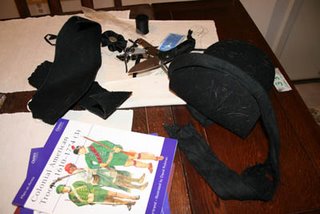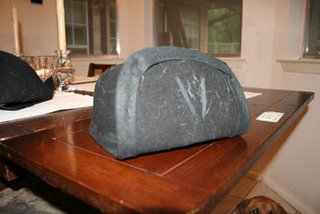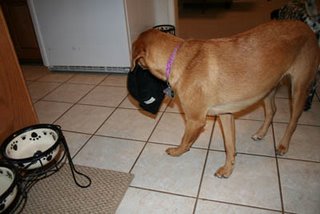One of the great things about the buckskinning hobby (lifestyle?) is everyone can take it as far as they want. There are some folks who love the idea of taking one blanket out into the woods or to an event and just throwing down on the ground. Others really like to bring out their “canvas castles” and set-up a fancy camp that would rival even Captain William Drummond Stewart.
Most events will set the ground rules for what is and isn’t ok beforehand – from primitive pack-ins where one’s accouterments and gear is scrutinized for accuracy to larger public events where pilgrims can walk among veterans in all states of dress.
I try my best to be as historically accurate when attending events, but there are some modern items I alway make sure are on hand – regardless of the time period of the event.
Being a volunteer medic, I always like to make sure I have a few essential items on hand, and I am also very serious about making sure I always have fresh, clean water to drink.
First Aid
No one likes getting hurt and this is my ultra-small list of essentials I make sure are always in my haversack. Feel free to be offended that I bring these out, but please have no shame in asking me if you find yourself needing anything while out on the trail.
Pain meds: Pain meds are good fever reducers as well as their obvious benefits in helping alleviate pain. However there are usually other liquid pain relievers at most events that are probably just as effective. Remember that ibuprofen primarily helps muscle-related pain and acetaminophen not only reduces pain, but also helps with severe itching due to insect bites and poisonous plants (pain receptors are riding on the same nerves that tell us to feel itchy, so it really works), so choose accordingly. I always bring out at least 2 doses of ibuprofen – usually 4 pills.
Allergy meds: I love the spring when everything is blooming and the fall when the weather changes again. Unfortunately these are also my prime allergy times and since I have a habit of throwing my bedroll down on this viney, leafy plant that seems to make my brain try to swell out of my head, I always make sure to pack along at least one Claritin-D.
Anti-diarrheal meds: One of the leading causes of death in the 1800s was diarrhea. Seriously. If you are planning on trying to forage on mystery plants and small, rodent-like animals, make sure that you have some of our modern “miracle” medicine to make sure that you don’t loose a dangerous amount of fluids while out trekking. Pack at least 2 doses of immodium or its generic counterpart.
Roll of medical tape: My theory is that I don’t need to pack along a lot of bandages if I have all of the makings of bandages right there with me. In truth, any clean cloth will do, but I like to have the added protection of completely covering a wound to keep out contaminants and then dealing with it when I get back to civilization. I always bring along a small roll of the waterproof kind.
This isn’t intended to be a primer on wilderness medicine, but the basic rule of thumb is that if you can pack out of the woods in 48 hours that is less time than in takes most infections to set-in from cuts or lacerations – but make sure to wash all out wounds (except serious burns) with clean, fresh water and let dry prior to applying a dressing. Any wound that is serious – that is bleeding that can’t be stopped, loss of consciousness due to trauma, falling from any distance over 6 feet, etc. – should be packed out immediately.
Anyone with known allergies should always bring along their epi pen or inhaler. If you are on regular meds, make sure you bring out those as well. Ten miles away from your car and your cell phone is no place to find out if you really do need those blood pressure meds.
I also really recommend taking a class in wilderness medicine if you are planning on spending any appreciable amount of time in the backcountry. Not only is it good for your own safety and the safety of your crew, but it’s great peace of mind for the family members who worry about you when you are in the woods.
Water purification
While many of us love the romantic ideal of wandering through the woods and drinking from crystal clear streams and springs, the reality is that its just not a good idea.
I have heard two schools of thought on this. One is that the 20th century has gotten us so used to ultra-purified foods and water that we are unable to deal with bacteria and viruses that has really been around for as long as we have – probably longer. The basic idea is that since we are more or less out of the habit of consuming these little nasties, we are basically getting sick with something that we would have already had to deal with earlier in life, in a more primitive time.
The second school of thought is that we are polluting our environment so much more – toxins, heavy metals, cow feces – that there simply isn’t many spots on earth that aren’t contaminated.
To be honest, I think it’s probably a little of both, which is why we have to make sure we can decontaminate all water we use in a wilderness setting.
Filtering water takes the nasties out of the water, while purification kills organisms that are in the water. The important thing to remember is that while purification will work against living nasties – bacteria, viruses, and other baddies – anything that is not alive to begin with – heavy metals, fertilizers, etc. – can’t be rendered inert by the purification process. These elements must be filtered out.
It’s for this reason that I recommend two steps to make water safe in the outdoors – filtering and purification – whether chemical (with iodine tablets or chlorine-based chemicals) or by boiling – which is much easier on the authenticity of an event.
Some contaminants – like giardia for instance – are even somewhat resistant to water purification chemicals and must really be boiled to ensure they are rendered inert.
There are all sorts of smaller water filters at places like REI and in about a million locations on the web. I recommend going into a backpacking store and talking to someone there to get an idea about what to buy. You’ll also want to have someone who can demonstrate how to use the filter as they can be a little tricky when you first start playing with one. Make them do this before you even buy the filter. You certainly don’t want to learn how to use it when your canteen is empty and you are two days walk from the last water source.
The good news is that many backpacking filters are small enough to fit into a small leather or canvas pouch and throw into your haversack. If you are worried about ruining the ambiance of an event, just grab the crew bucket or a tin pot, shamefully walk over to your water source, and then do the filtering away from the rest of the group.
Your crew may not like seeing the plastic device, but you only need to get sick one time to appreciate how great they are. Just remember that filtering is the first step and make sure to boil the water back at camp. Once boiled, you can let the water cool and then add it to your canteen or water container. Some vigorous shaking of the container (make sure the lid is on) helps get rid of the flat taste of boiled water. I think the end result tastes better than using tablets and it’s also much more safer.
Be careful! 🙂
– Many Rifles



 The final product. It needs a plume or some other cool decoration.
The final product. It needs a plume or some other cool decoration. 
